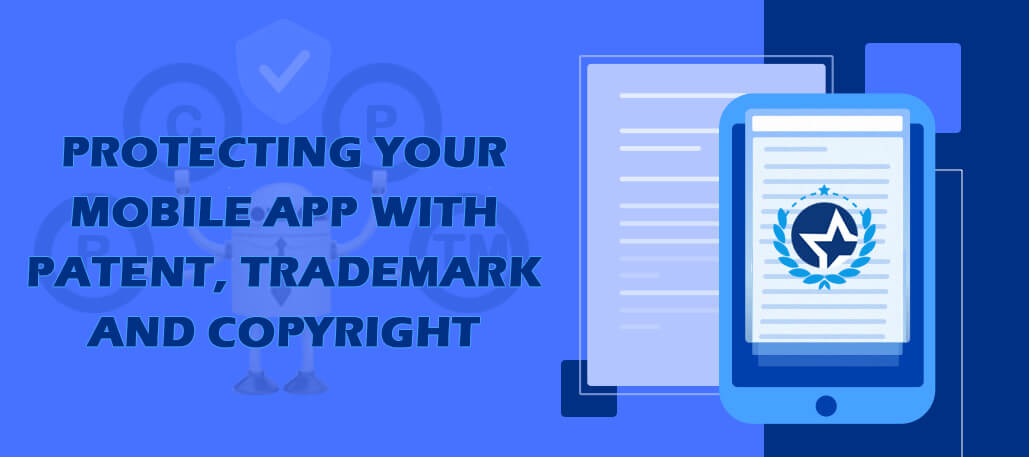
Protecting Your Mobile App with Patent, Trademark and Copyright
Unsure about what intellectual property rights you require to secure your mobile app? Take a look!
Table of Contents
It is important to be proactive when it comes to securing your mobile app. How should I legally protect my mobile app? Various factors that need to be considered here are the cost of the mobile app, the IP protection, protecting the liability and protecting the intellectual properties.
How to protect your liability?
Terms and conditions: Having a set of documents clearly outlining the eligible terms and conditions which prevent the misuse of the application and claims initiated by people who use your app. This includes a disclaimer that illustrates that you will not be held responsible for any information that is being displayed incorrectly on your app. This will also state that you cannot be held liable for any information that the user may have depended upon while visiting your app.
- Privacy Policy: A privacy policy is laid by every app owner and cookie settings depend upon the client-browser settings. Users may have to accept cookies if they have no objection against the random mobile apps collecting their data.
- Confidentiality Agreement: All the concerned stakeholders, consultants, employees, programmers, developers etc. must sign a non-disclosure agreement if they are directly or indirectly involved in the creation of the app.
- IP Assignment Agreement: When someone is hired to work, they must be assigned the claim to the property.
- Copyright: This implies that your written code is an original work of authorship and is protected by copyright laws as soon as you create and publish it online. You need to register your copyright if you ever want to sue someone for infringement. If developers make use of open source code, that is not eligible to be registered with the U.S. Copyright Office.
- Trademarks: Similar to copyrights but delicately different, Trademarks protect your app’s name, logo and slogan. With some preliminary protection, the app must always be registered for the trademark to protect your business nationwide and globally. This informs others who might consider using your app’s name and allows you to sue in federal court for infringement of your registered trademark.
- Patent: It might be challenging to apply for a patent. It is one of the most complex and expensive forms of IP Protection. But a business needs to ensure that if their app is patentable
How to Patent an app?
A patent specifically utility patent protection protects a mobile app for a term of twenty years from the filing. The patentability of the app depends in part on the nature of the invention and in part upon the skills of the patent drafter. The strategy to identify and implement fundamental economic practices involves that is the app merely collecting and displaying the data or is simply automating well-known processes. Are there any kind of inventions that are likely unpatentable abstract ideas or some improvements are required to make it patentable?
Utility Patent: What are the eligibility criteria for an app to acquire a patent?
Does a business need to identify if the app requires a patent? It usually takes more than 2 years to acquire a patent and costs around $10,000 – $15,000. It is for the app developer to consider whether the commercial prospects for the app justify this cost and whether the app’s anticipated life will outlast the application process. It is for the business to make the decision within one year of the first public disclosure or sale of the app and to avoid any complications.
Design Patent: Protecting the Design
The function of the app is accompanied by the design patent which protects the appearance of the app’s icon and its user interface. It has a term of 15 years from the issuance and allows its owner to stop others from using an icon or an interface that so similar in appearance to the patented design that a purchaser could confuse them. Design patents cost less, usually takes less than two years to get approved and cost comes within $2500.
Protecting Trademark
Protecting a trademark includes the name of the app, the appearance of its icon, and the appearance of its user interface. It is up to the app developers to start with the process early by applying to register its marks based upon the intention to use them.
All these steps in the process help avoid infringement claims and save development teams from wasting time and resources in building the rights in a mark that you will later have to change. These also help prevent app icons to protect features of the app interfaces from getting copied.
Protecting Copyright
Copyright safeguards the graphical content of the app. It requires two steps: Putting the copyright notice on work and registering the copyright. This can be handled in as less as $35. But this requires registration as a prerequisite to any sort of infringement action. Copyright does not protect the app from an independent creation.
In Conclusion
The most important first step in protecting the rights of any mobile application is to recognize the trade secrets and educate the team on how to protect them. Non-disclosure Agreements are designed to address a specific situation reflecting a two-way communication process between you and your partners. Right from protecting a business’s identity, these intellectual properties refer to the rights associated with intangible knowledge or concepts that businesses take to the market. The only challenge lies in watching someone else take your idea for a great app to successful reality. The earlier the better. All these intellectual property laws provide robust protection for apps and help top app development companies to plan.
